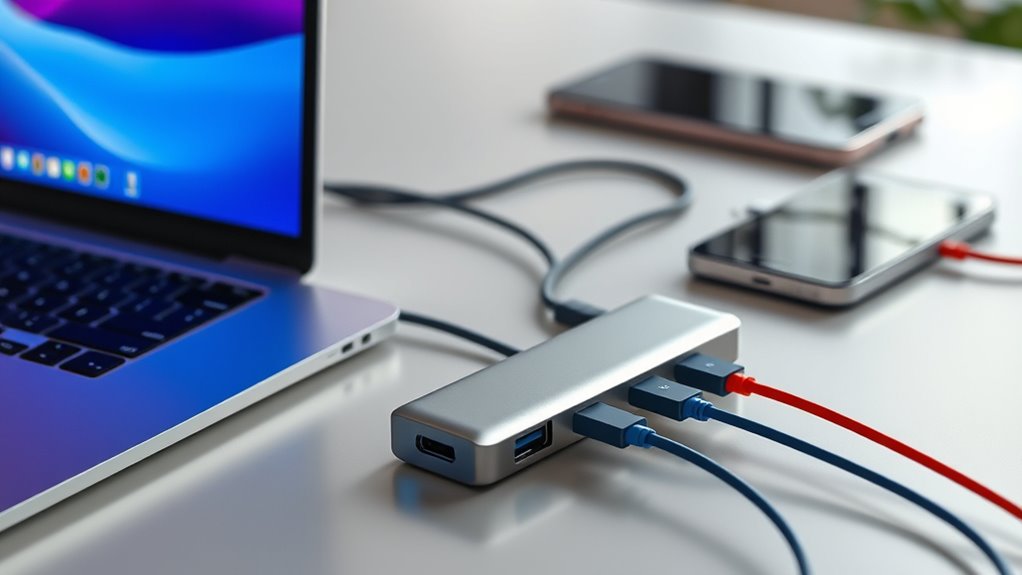If you’re looking to expand your connectivity in 2025, I recommend checking out the top USB hubs that fit various needs. From compact 4-port options like Acer’s to powerful 10-port hubs with PowerIQ, there’s a perfect match for every setup. Consider features like data transfer speed, power delivery, and port variety to get the best value. Keep exploring to find the ideal hub that balances performance and durability for your device needs.
Key Takeaways
- Top USB hubs offer high-speed data transfer with USB 3.0, USB4, or Thunderbolt standards for fast large-file management.
- Many models include multiple ports like USB-A, USB-C, HDMI, SD/TF card readers, and Ethernet for versatile connectivity.
- Features such as power delivery (up to 100W), individual port switches, and LED indicators enhance device management and performance.
- Compact, durable designs with external power supplies ensure reliable operation and portability for various environments.
- Compatibility across Windows, Mac, Linux, and ChromeOS, with plug-and-play setup, makes these hubs suitable for diverse devices.
Acer USB Hub 4 Ports
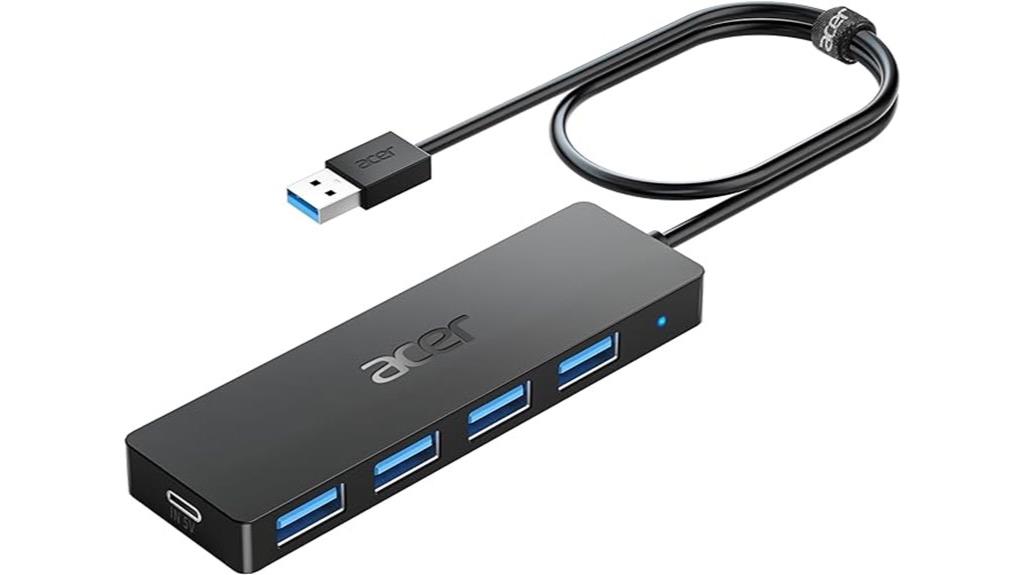
If you’re looking for a reliable USB hub that boosts your device connectivity, the Acer USB Hub 4 Ports is a top choice. It offers four USB 3.0 ports, perfect for connecting flash drives, mice, keyboards, and printers simultaneously. The built-in GL3510 chip guarantees safe data transfer and prevents overheating. It’s plug-and-play, so no driver installation is needed. With transfer speeds up to 5Gbps, you can quickly move files. Its slim, durable design with a 2ft cable makes it ideal for travel. Just remember to connect it to a 5V USB-C power source for stable operation, especially with external drives.
Best For: users seeking a portable, reliable USB hub to expand device connectivity for travel, work, or gaming setups.
Pros:
- Supports four USB 3.0 ports with high-speed data transfer up to 5Gbps.
- Plug-and-play design requires no driver installation, ensuring easy setup.
- Durable, lightweight construction with a 2ft cable ideal for mobile use.
Cons:
- Requires connection to a 5V USB-C power source for stable operation, especially with external hard drives.
- The USB-C port marked “IN 5V” supplies power only and cannot transfer data or charge devices.
- Overvoltage or improper power sources may cause overheating or potential damage.
Anker 4-Port USB Hub (2ft USB-A)
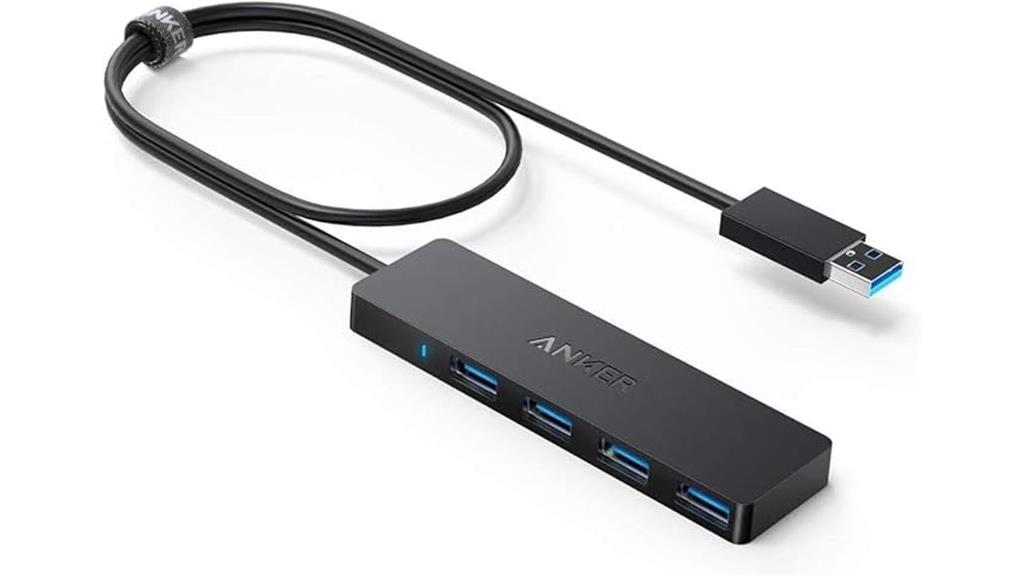
The Anker 4-Port USB Hub (2ft USB-A) is an excellent choice for users needing reliable expansion for their laptops or desktops. Trusted by over 80 million users, Anker delivers dependable technology solutions. This hub supports SuperSpeed data transfer up to 5Gbps, so transferring large files or HD movies is quick and seamless. It converts one USB port into four, boosting your connectivity options without clutter. Built for durability, it’s heat-resistant and designed for long-lasting use. The package includes the slim, 2ft USB-A cable, an easy-to-follow guide, and an 18-month warranty with friendly customer support.
Best For: those seeking a reliable, high-speed USB expansion solution for laptops, desktops, or PCs that requires quick data transfer and durable design.
Pros:
- Supports SuperSpeed data transfer up to 5Gbps for fast file transfers
- Converts a single USB port into four, enhancing connectivity options
- Built with heat resistance and durability for long-lasting performance
Cons:
- Does not support device charging, limiting its use for powering peripherals
- Requires a 2ft USB-A cable, which may be less flexible in tight spaces
- May not be compatible with all devices or operating systems without additional drivers
USB Hub 3.0 7-Port Splitter with On/Off Switches
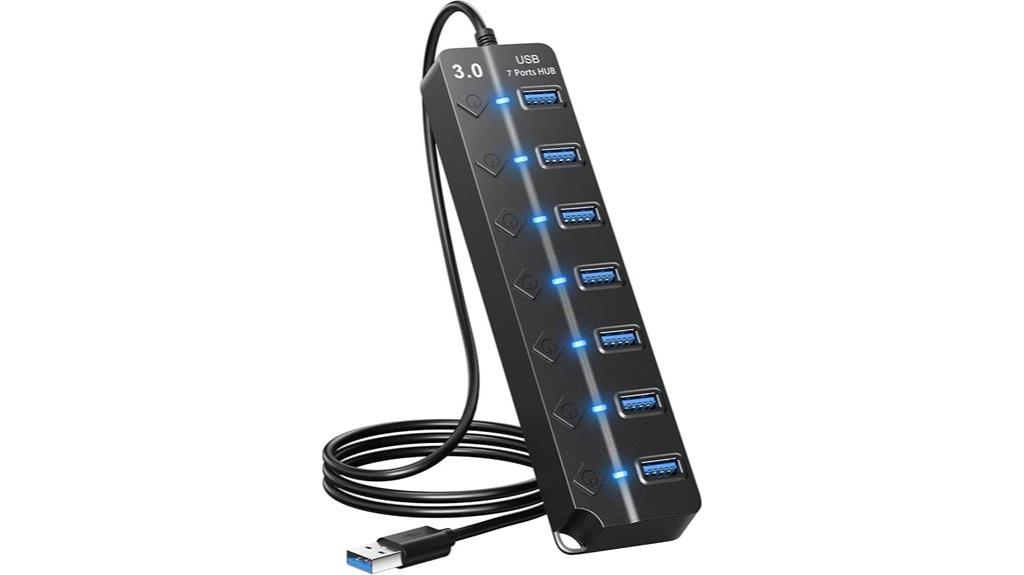
For those seeking a versatile and budget-friendly USB hub, the ONFINIO USB Hub 3.0 7-Port Splitter with On/Off Switches stands out. It turns a single USB port into seven, supporting a wide range of USB-A devices like flash drives, printers, and external HDDs. With data speeds up to 5Gbps, it ensures fast transfers for large files and HD videos. The individual on/off switches and indicator lights make managing devices easy. Its compact, lightweight design with a 3.2ft cable makes it perfect for laptops and travel. While lacking USB-C ports, it’s a reliable, simple solution for expanding connectivity without external power.
Best For: users seeking an affordable, portable USB hub to expand their device connectivity for everyday office, travel, or home use.
Pros:
- Supports data transfer speeds up to 5Gbps for quick file sharing and HD video streaming
- Equipped with individual on/off switches and indicator lights for easy device management
- Compact and lightweight design with a long cable, ideal for portable use with laptops and ultrabooks
Cons:
- Lacks USB-C ports, limiting compatibility with newer devices that primarily use USB-C
- May require specific device connection order to prevent errors during setup
- Some ports may malfunction over time due to manufacturing weaknesses or frequent disconnections
Anker 10 Port USB 3.0 Hub with PowerIQ Charging
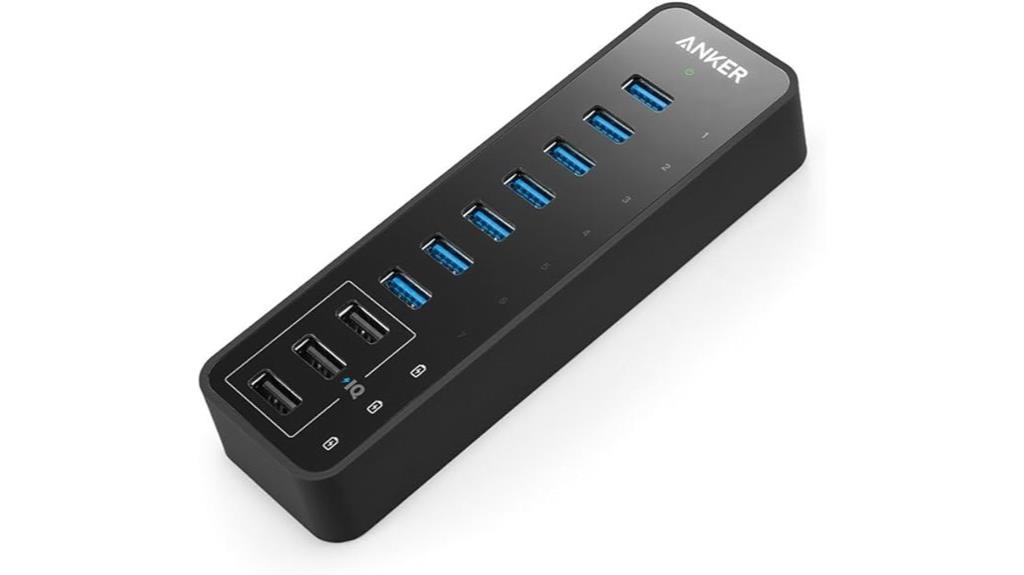
Designed for power users who need multiple high-speed connections and fast device charging, the Anker 10 Port USB 3.0 Hub with PowerIQ Charging offers a robust solution. It features 7 data transfer ports supporting speeds up to 5Gbps and 3 dedicated charging ports delivering up to 2.1 amps each, perfect for phones and tablets. Powered by a 60W power supply, it guarantees all ports operate simultaneously at full capacity. Its compact size and glossy white finish save workspace, while blue LED indicators help identify active ports. Compatible with Windows, Mac, and Linux, this hub reliably handles external drives, media, and mobile device charging.
Best For: power users needing multiple high-speed data connections and efficient device charging simultaneously.
Pros:
- Supports rapid data transfer speeds up to 5Gbps for quick file sharing.
- Includes 3 dedicated PowerIQ charging ports delivering up to 2.1A each, ideal for fast mobile device charging.
- Compact design with a glossy finish and LED indicators enhances usability and workspace conservation.
Cons:
- External power adapter can block adjacent outlets; power strips with swiveling plugs may be needed.
- Some USB devices, like certain wireless peripherals or MIDI devices, may not be fully compatible.
- The hub may not work reliably with some Apple devices such as iPods or iPhones when connected through the hub.
Powered USB Hub 3.0 with 7 Ports and Smart Charging
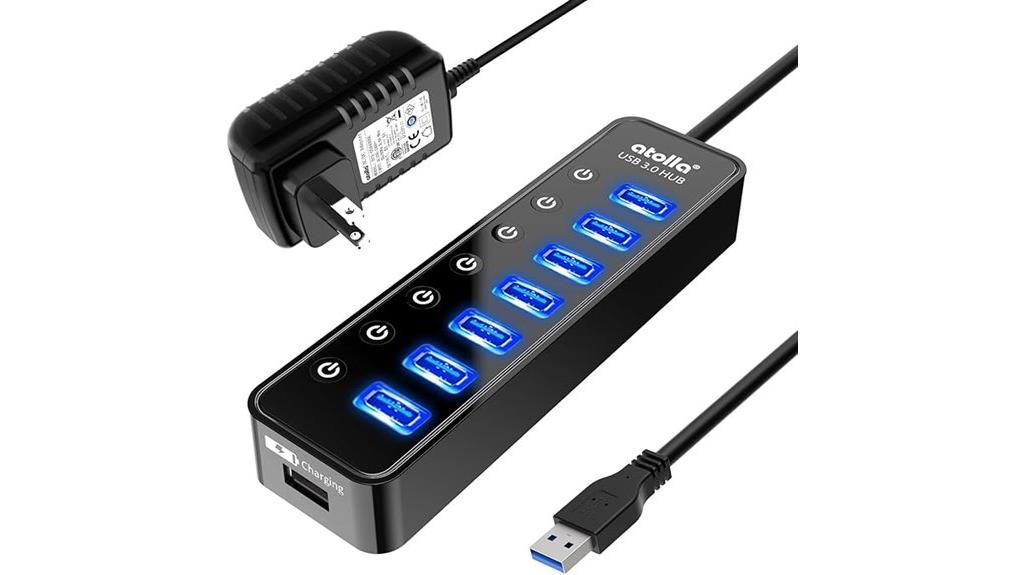
If you need a reliable way to expand your USB connectivity while guaranteeing fast charging, the Powered USB Hub 3.0 with 7 Ports and Smart Charging is an excellent choice. It instantly adds seven high-speed data ports, supporting transfer speeds up to 5Gbps, and includes a dedicated smart charging port that quickly and safely powers devices like iPhones and iPads. Each port has its own on/off switch, giving you control and reducing clutter. Its sturdy build, compatibility across multiple operating systems, and the ability to daisy-chain make it versatile for both home and professional setups. The external power supply ensures ample power, making multitasking seamless.
Best For: users needing to expand their USB ports with high-speed data transfer and safe charging capabilities for multiple devices at home or in the office.
Pros:
- Supports high-speed data transfer up to 5Gbps, ideal for large file transfers and external drives.
- Includes a dedicated smart charging port for fast, safe device charging without occupying data ports.
- Individual on/off switches for each port enhance device management and reduce cable clutter.
Cons:
- Size may take up desk space, making it less portable for on-the-go use.
- Occasional detection issues with certain USB flash drives.
- The external power supply can fail over time, requiring replacement for continued optimal performance.
Anker USB C Hub, 5-in-1 USBC to HDMI & USB Adapter
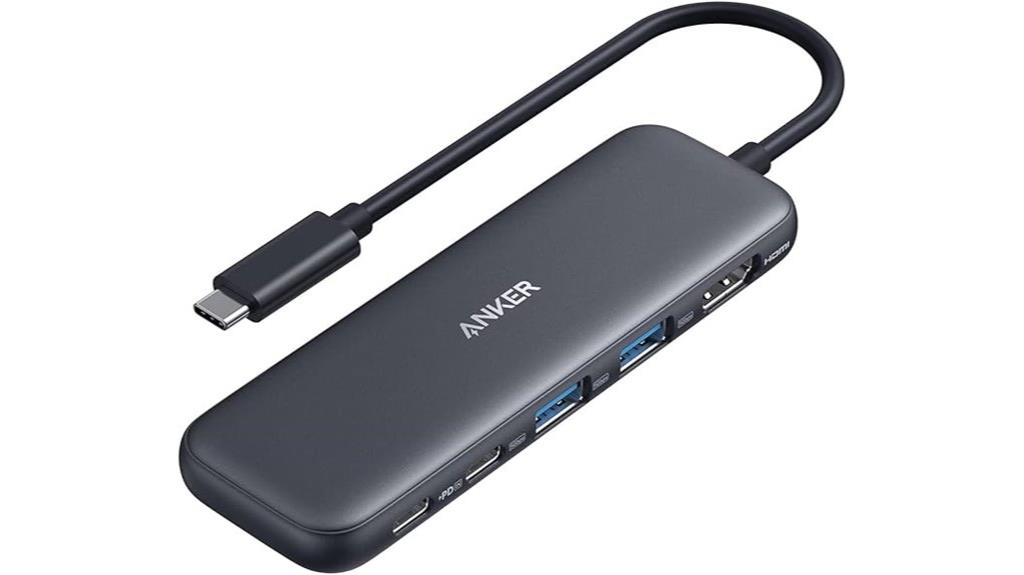
The Anker USB C Hub, 5-in-1 USBC to HDMI & USB Adapter, stands out as an excellent choice for professionals and travelers who need reliable, versatile connectivity on the go. It supports USB-C, USB4, Thunderbolt, macOS (12+), Windows 10/11, and ChromeOS, making it highly compatible. The hub offers 4K HDMI output at 30Hz, two USB-A 3.0 ports, a USB-C data port, and a 100W power delivery input for charging. Its compact, lightweight design makes it perfect for travel, and the solid build quality guarantees durability. It’s a reliable, all-in-one solution for expanding your device’s connectivity effortlessly.
Best For: professionals, travelers, and anyone needing a reliable, versatile hub to expand device connectivity with external displays and fast charging capabilities.
Pros:
- Supports multiple connectivity standards including USB-C, USB4, and Thunderbolt for broad device compatibility
- Compact and lightweight design ideal for travel and on-the-go use
- Reliable plug-and-play setup with no overheating or connection issues
Cons:
- Limited HDMI audio support at 1080p@60Hz, requiring adjustment to 50Hz for better audio
- Not compatible with Linux operating systems
- USB C PD-IN port only supports charging, not data or audio transfer
USB 3.0 Hub, VIENON 4-Port USB Hub and Splitter
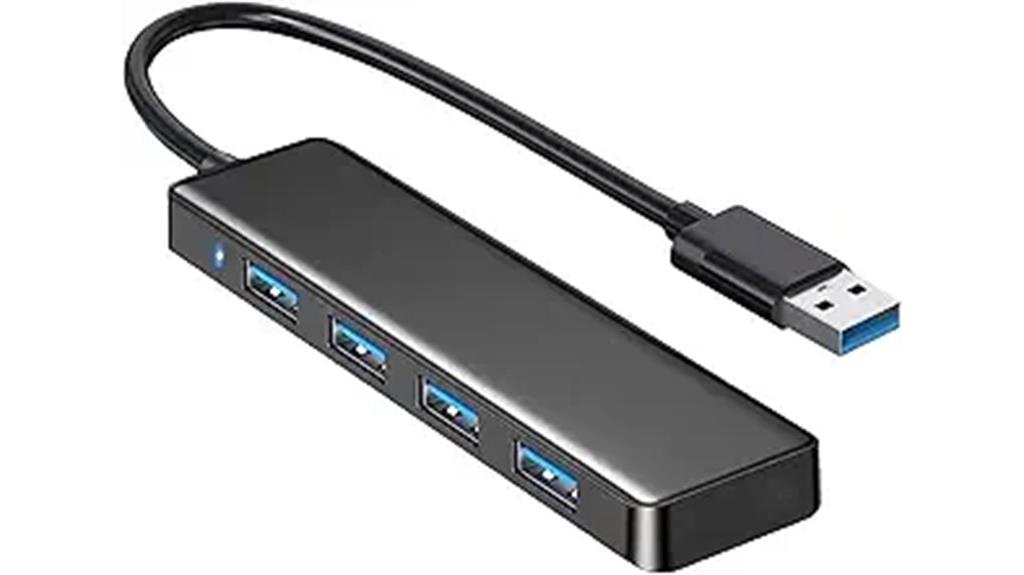
For anyone needing to expand a single USB port into multiple connections without sacrificing speed, the VIENON 4-Port USB 3.0 Hub and Splitter offers a reliable solution. It transforms one port into four active, easy-to-access ports, supporting devices like flash drives, keyboards, mice, and more. With a compact, ultra-slim design and LED indicators, it’s perfect for space-saving setups. Capable of SuperSpeed data transfer at 5 Gbps, it handles HD movies and large files quickly. Plug-and-play and compatible with USB 1.0, 2.0, and 3.0, it’s a practical choice for expanding connectivity on laptops, PCs, or gaming consoles.
Best For: users seeking an affordable, easy-to-use USB 3.0 hub to expand multiple device connections with high-speed data transfer capabilities.
Pros:
- Supports SuperSpeed data transfer at 5 Gbps for quick large file transfers and HD movie streaming
- Plug-and-play setup with no driver installation needed, compatible with USB 1.0, 2.0, and 3.0 devices
- Compact, ultra-slim design with LED indicators for easy status monitoring and space-efficient port placement
Cons:
- Some users experience durability issues, with devices failing after a short period of use
- Short cable length can be inconvenient for wired device connections or larger setups
- Compatibility and recognition can be inconsistent; certain devices may not work as expected
SABRENT 10-Port USB 3.0 Hub with Power Adapter
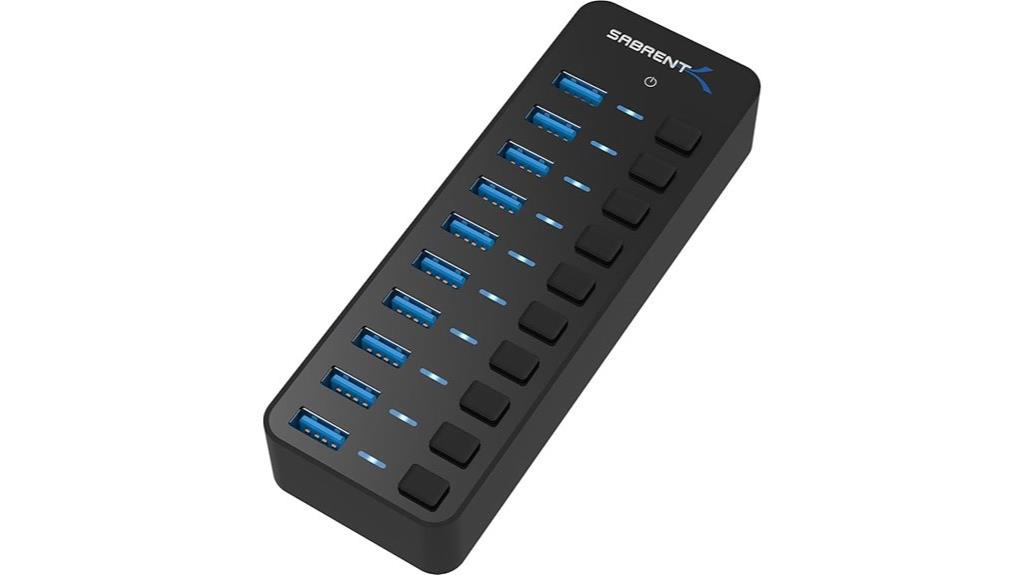
When managing multiple USB devices, the SABRENT 10-Port USB 3.0 Hub with Power Adapter stands out as an ideal solution for power users who need reliable, high-speed connectivity. Its compact design features a sleek mirrored surface and individual power switches with blue LEDs for easy control over each port. Supporting data transfer speeds up to 5Gbps and equipped with a 60W external power supply, it handles multiple peripherals like drives, card readers, and charging devices without performance drops. Compatibility across Linux, Mac, and Windows makes setup seamless. Most users find it reliable and versatile, perfect for studio setups, gaming rigs, or busy offices.
Best For: power users who need reliable, high-speed USB connectivity and individual port control for multiple peripherals in studio, gaming, or office environments.
Pros:
- Supports fast data transfer speeds up to 5Gbps for quick file and data movement
- Equipped with a 60W external power adapter to handle multiple power-hungry devices simultaneously
- Features individual switches with LED indicators for easy port management and power control
Cons:
- Some users experience unreliable port recognition with certain devices or hardware configurations
- Lightweight design may require securing to prevent accidental disconnection or movement
- Occasional system reboots reported, which can be resolved by disconnecting the hub
Sabrent 4-Port USB 3.0 Hub with LED Power Switches
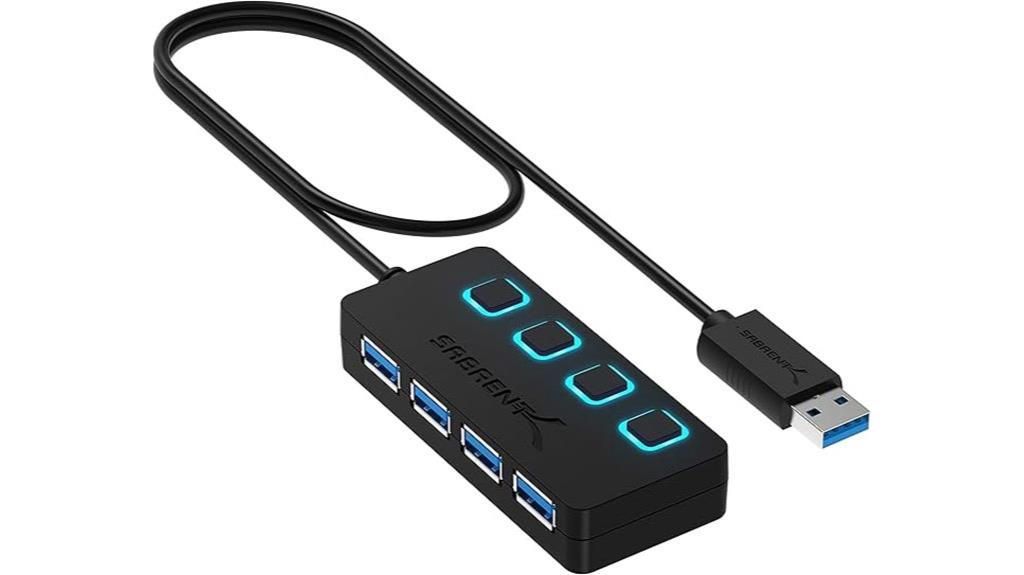
Looking for a compact and reliable USB hub that makes connecting multiple devices effortless? The Sabrent 4-Port USB 3.0 Hub with LED Power Switches is perfect. Its slim design and 2-foot cable offer flexible setup, whether on a desk or in your bag. Each port has its own LED switch, so you can easily control devices without unplugging. Supporting data transfers up to 5Gbps, it’s fast and dependable for large files. Made of durable plastic and compatible with Mac, Windows, and Linux, it’s lightweight and travel-friendly. While not built for charging, it’s an excellent choice for expanding your USB connectivity efficiently.
Best For: users seeking a portable, easy-to-use USB hub to expand connectivity across laptops, desktops, and on-the-go setups without the need for drivers.
Pros:
- Compact, lightweight, and travel-friendly design for convenient portability
- Individual LED power switches for easy control over each device connection
- Supports high-speed data transfer up to 5Gbps, ideal for large file transfers
Cons:
- Made of cheap plastic, which may raise durability concerns over time
- Indicator LEDs can fail after extended use, though ports remain functional
- Lacks charging capabilities and additional features found in higher-end hubs
TP-Link Powered USB Hub with 7 USB 3.0 Ports and 2 Charging Ports
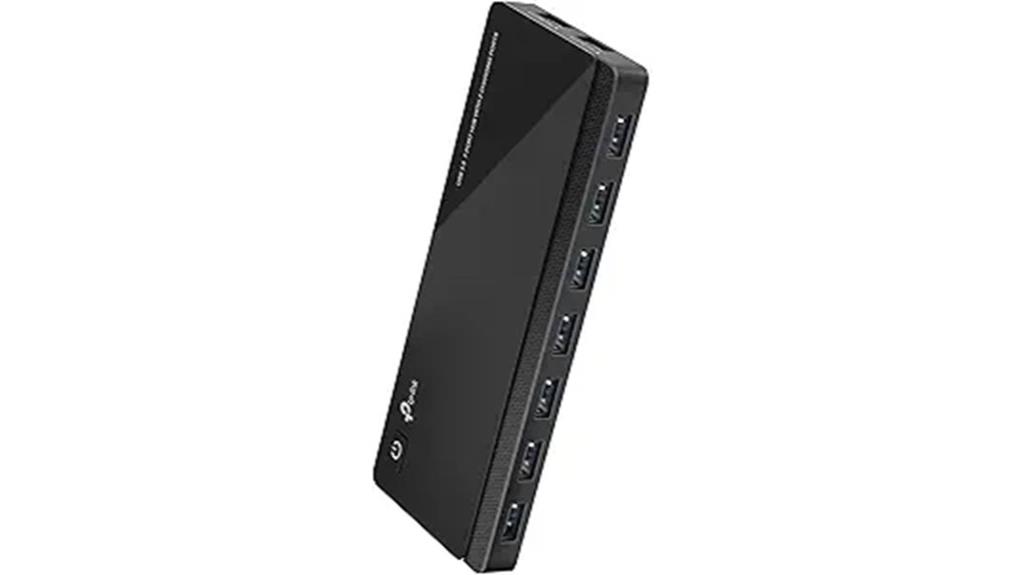
If you need a reliable and high-capacity USB hub that can handle multiple peripherals simultaneously, the TP-Link Powered USB Hub with 7 USB 3.0 ports and 2 charging ports is an excellent choice. It offers fast data transfer speeds up to 5Gbps, backward compatibility with USB 2.0 and 1.1 devices, and two smart charging ports delivering 5V/2.4A for quick power-ups. The hub features a sturdy build, plug-and-play operation, and a convenient power on/off button. Its hot-swappable ports allow safe connection and disconnection, making it ideal for busy setups needing stable, versatile, and fast connectivity across Windows, Mac, Linux, and Chrome OS.
Best For: power users and professionals who need reliable, high-speed, and versatile USB connectivity for multiple peripherals and devices across various operating systems.
Pros:
- Fast data transfer speeds up to 5Gbps with USB 3.0 ports.
- Robust build quality with plug-and-play ease and hot-swappable ports.
- Two smart charging ports for quick power-up of smartphones and tablets.
Cons:
- Compatibility issues may arise with Windows 11 unless using the UH720 V4 model.
- Non-charging data ports provide limited power, unsuitable for charging devices.
- Potential interference with 2.4GHz wireless devices when near USB 3.0 ports.
Powered USB Hub with 11 Ports and Individual Switches
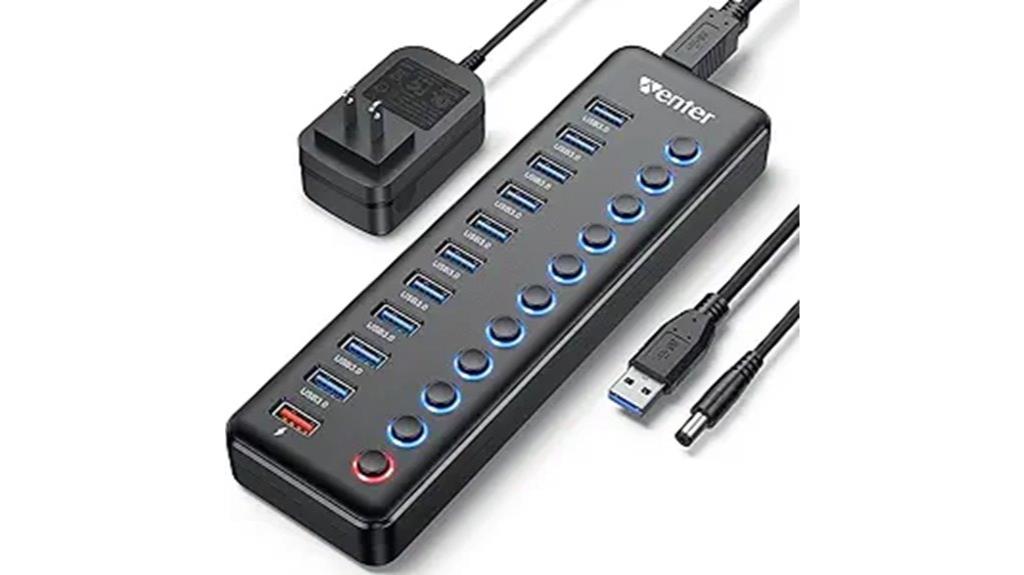
The Powered USB Hub with 11 Ports and Individual Switches is an excellent choice for users who need precise control over multiple devices. It offers 10 data ports with USB 3.0 speeds up to 5Gbps and a dedicated smart charging port delivering up to 2.4A. Each port has its own LED indicator and switch, allowing you to turn devices on or off without unplugging. Powered by a 12V/3A adapter, it supports plug-and-play setup across Windows, Mac, and Linux. Its sleek strip design fits well on desktops or gaming rigs, making device management simple, organized, and efficient.
Best For: users who need reliable, high-speed data transfer and efficient device management for multiple peripherals like external drives, smartphones, and gaming equipment.
Pros:
- Supports USB 3.0 with transfer speeds up to 5Gbps for rapid data syncing.
- Individual switches and LED indicators for easy, selective control of each port.
- Powered with a stable 12V/3A adapter, supporting multiple devices simultaneously with dedicated charging port.
Cons:
- Slightly larger strip design may require additional desk space.
- Minor reports of build quality issues with port pins over time.
- Requires external power supply, which adds to cable clutter for some setups.
USB C Hub, INTPW 9-in-1 Multiport Adapter
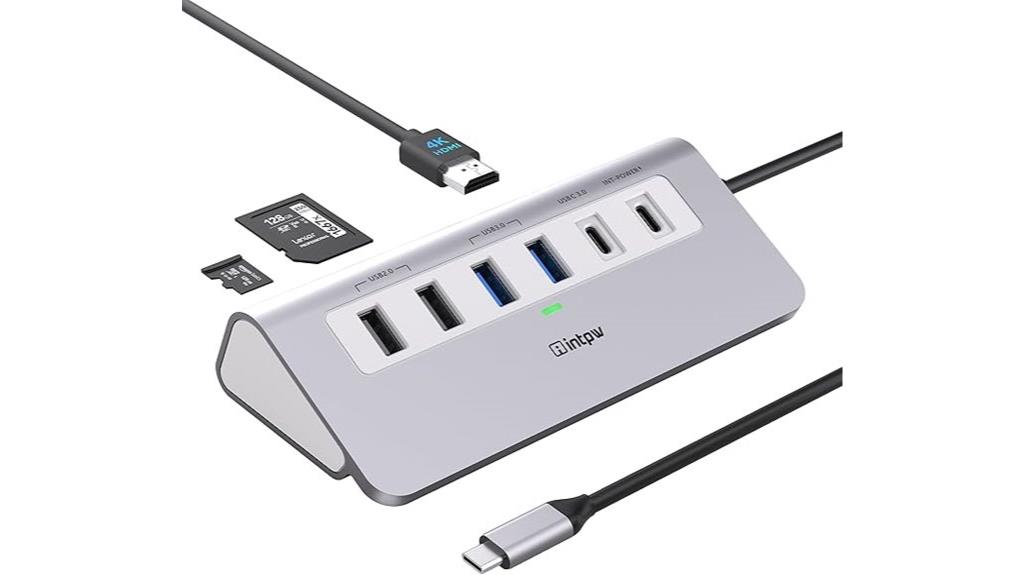
The INTPW 9-in-1 Multiport Adapter is an excellent choice for anyone who needs a versatile, portable hub to expand their device’s connectivity options. It combines essential ports into a compact, durable aluminum design, compatible with MacBooks, Chromebooks, and other Type-C devices. It features a 100W PD charging port, multiple USB A ports (both 3.0 and 2.0), HDMI supporting 4K at 30Hz, SD/TF card readers, and a USB C data port. Its plug-and-play setup makes it easy to use on the go, and the heat-dissipating build guarantees stable performance during extended use. It’s ideal for multitasking and multimedia needs.
Best For: professionals, students, and multimedia enthusiasts who need a portable, versatile hub to expand their device’s connectivity and support high-quality video and data transfer.
Pros:
- Combines multiple essential ports into a compact, durable aluminum design for portability and style
- Supports 4K HDMI output at 30Hz and fast charging with 100W Power Delivery for efficient multitasking
- Plug-and-play setup with heat dissipation features ensures stable performance during extended use
Cons:
- HDMI supports only up to 4K@30Hz, limiting higher refresh rate options for gaming or fast-paced video
- USB C PD port is designated only for charging and does not support data transfer
- Requires a device with USB-C port supporting DisplayPort Alt Mode for HDMI and video output functionality
Factors to Consider When Choosing Usb Hubs
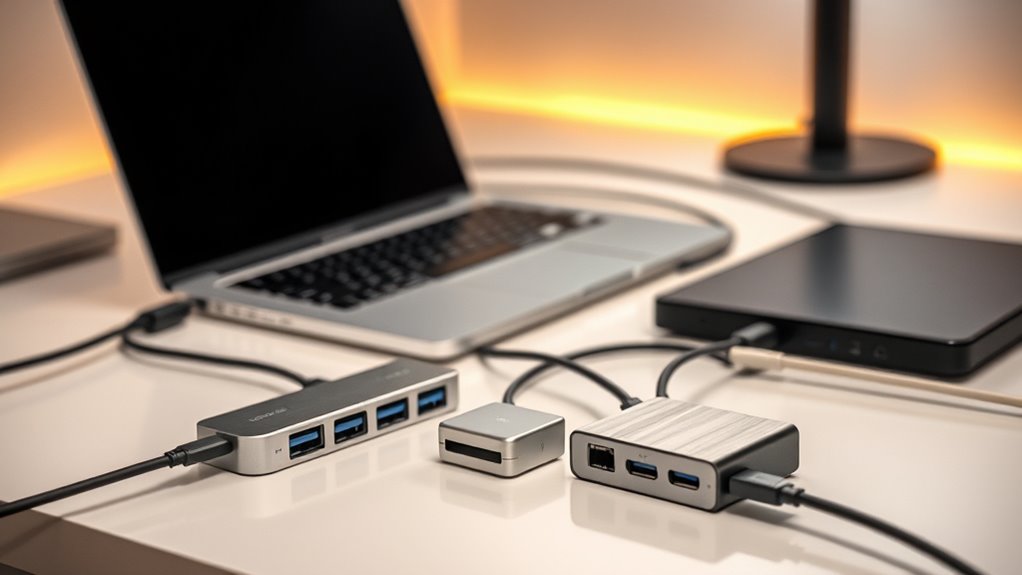
When selecting a USB hub, I consider compatibility with my devices to guarantee seamless connection. I also look at data transfer speeds and power requirements to match my usage needs. Finally, I evaluate the number and types of ports to find the best fit for all my peripherals.
Compatibility With Devices
Choosing the right USB hub means making sure it’s compatible with your devices, so everything works smoothly. First, check that it supports the same USB standard as your gadgets—whether USB 2.0, 3.0, 3.1, 3.2, or USB-C—for peak performance. Also, verify compatibility with your operating system, like Windows, macOS, Linux, or ChromeOS, to prevent driver issues. The hub’s physical connection type should match your device’s ports—USB-A, USB-C, Thunderbolt, or USB-C with Power Delivery—to ensure seamless connectivity. Additionally, confirm it supports the specific device types you plan to connect, such as external drives or printers, for proper functionality. Finally, consider whether it’s bus-powered or needs an external power source to meet your device’s power needs.
Data Transfer Speed
Ensuring your USB hub supports the right data transfer speed is key to maintaining smooth workflows, especially when handling large files or high-definition media. USB 3.0 and newer standards support transfer speeds up to 5Gbps, enabling quick data movement. However, actual performance depends on the slowest connected device or cable, so using compatible cables and devices is essential. The type of USB port also directly affects maximum transfer rates—USB-C and USB 3.0 ports are generally faster than USB 2.0. For maximum speed, look for hubs that support features like UASP, which reduces latency and boosts throughput. Choosing a hub with high transfer capabilities ensures efficient data handling for tasks like HD editing, backups, and large file transfers without bottlenecks.
Power Supply Requirements
A reliable power supply is vital for a USB hub to perform at its best, especially when connecting multiple devices or power-intensive peripherals. I recommend choosing a powered hub with a dedicated external power adapter, like 5V/4A or higher, to guarantee stable data transfer and prevent overloading your computer’s USB port. Relying solely on bus power from the host device can limit the number of devices you connect and may reduce performance. It’s essential to verify that the power supply matches the hub’s specifications and provides enough wattage to support all peripherals simultaneously. Using a hub with a proper external power source also helps prevent overheating, data transfer errors, and device malfunctions caused by insufficient power. This approach guarantees smoother operation and greater reliability.
Number of Ports Needed
When selecting a USB hub, figuring out how many ports you need is the first step. Think about all the devices you plan to connect now and in the near future—this helps make sure you choose a hub with enough capacity. It’s wise to take into account potential expansion; opting for a hub with extra ports can save you from upgrading later. Keep in mind, a hub with many ports might require an external power source to keep everything running smoothly. Also, larger hubs tend to be less portable, which matters if you need a travel-friendly option. Finally, more ports can impact power distribution and data transfer speeds, so choosing the right number balances your current needs with future growth while maintaining performance.
Port Types and Features
Choosing the right USB hub means paying close attention to the types of ports it offers. Different hubs provide various port options like USB-A, USB-C, HDMI, SD card readers, and Ethernet, tailored to specific needs. Having multiple port types lets you connect a range of devices for data transfer, charging, or video output, enhancing versatility. Some hubs feature dedicated charging ports, such as 100W USB-C PD ports, for fast device charging. Usability is also improved with features like on/off switches, indicator lights, and port-specific controls. Compatibility with standards like USB 2.0, 3.0, 3.1, 3.2, and Thunderbolt impacts data transfer speeds and device support. Considering these port types and features guarantees you select a hub that fits your workflow perfectly.
Build Quality Durability
The build quality of a USB hub directly impacts its durability and long-term performance. I look for hubs made from high-quality materials like aluminum or reinforced plastic, as they resist wear and tear better. Robust construction with reinforced ports and connectors helps prevent damage from frequent plugging and unplugging. Proper heat dissipation features are also essential; they keep internal components cool and reduce overheating risks. I pay attention to reinforced cable joints and strain relief, which protect against cable fraying and internal wire breakage. A sturdy build is especially important if I plan to use the hub in travel, busy offices, or industrial environments where impacts and rough handling are common. Ultimately, a well-built hub ensures reliable performance and longevity over time.
Port Management Options
Effective port management is essential for maximizing a USB hub’s usability and efficiency. Features like individual on/off switches allow me to control power to each device without unplugging, keeping my workspace tidy and saving energy. LED indicators for each port give clear visual confirmation of active connections, making troubleshooting straightforward. Multiport hubs with dedicated charging ports let me transfer data and charge devices simultaneously, simplifying device management. Hot-swappable ports are a game-changer, enabling me to connect or disconnect devices on the fly without powering down the hub. Additionally, ports with different data transfer speeds and power capabilities require careful selection to match my devices’ needs, ensuring peak performance. These management options make my setup more organized, flexible, and efficient.
Frequently Asked Questions
How Do USB Hubs Affect Data Transfer Speeds?
USB hubs can impact data transfer speeds based on their specifications. When I use a high-quality hub with USB 3.1 or 3.2 ports, I notice faster data transfer compared to older or cheaper hubs. However, if the hub is limited to USB 2.0, my transfer speeds slow down greatly. So, choosing a hub with the right standards guarantees I get the best speeds for my devices.
Are Powered USB Hubs Safer for Device Protection?
Yes, powered USB hubs are safer for your devices. I’ve seen how they prevent power surges and overloads that can fry sensitive components. Imagine plugging in multiple gadgets, each drawing just the right amount of juice—power is stable, and devices stay protected. With an external power source, your devices get consistent, clean energy, reducing risks of damage. It’s like giving your tech a secure, steady handshake every time.
Can USB Hubs Support Multiple 4K Monitors Simultaneously?
Yes, many USB hubs can support multiple 4K monitors at once, but it depends on their specifications. I’ve found that hubs with Thunderbolt 3 or 4, or USB-C with DisplayPort Alt Mode, handle dual or even triple 4K displays smoothly. Make sure the hub provides enough bandwidth and power delivery. Always verify the manufacturer’s details to guarantee compatibility with your monitors and device setup.
What Is the Average Lifespan of a USB Hub?
The average lifespan of a USB hub is around 3 to 5 years, depending on usage and build quality. I’ve found that well-made hubs with good ventilation tend to last longer. Regularly disconnecting devices when not in use and avoiding power surges can also extend their life. If you notice slow data transfer or physical damage, it’s time to evaluate a replacement to keep your setup running smoothly.
Do USB Hubs Work With All Operating Systems?
A USB hub is like a universal key, but it doesn’t open every door. Generally, most USB hubs work with all major operating systems like Windows, macOS, and Linux. Still, compatibility can vary, especially with specialized or older OS versions. I recommend checking the hub’s specifications before buying to make certain it’ll work seamlessly with your system, so you don’t end up locked out of your connectivity options.
Conclusion
With so many great options, expanding your connectivity has never been easier. Did you know that over 70% of users say they rely on USB hubs daily for work and entertainment? Whether you need a compact 4-port or a versatile 9-in-1, there’s a hub for everyone. Choose wisely, and you’ll enjoy seamless device connections and improved productivity. Happy connecting!
Fritz is a writer whose humor and wit infuse life into words. His creativity, combined with a profound love for the English language, makes him a unique voice at afterQuotes. Fritz’s engagement with books, culture, and social media adds depth to his contributions, making them resonate with our diverse audience.
